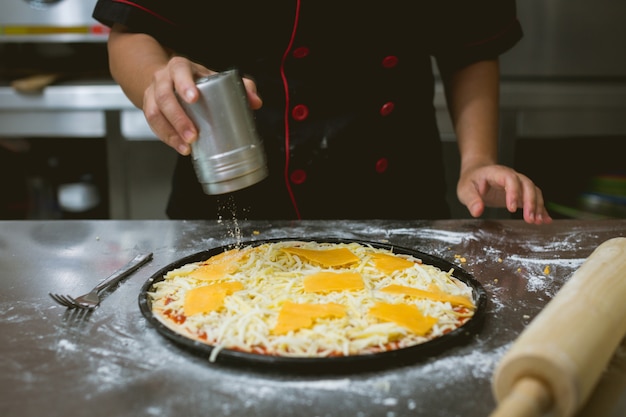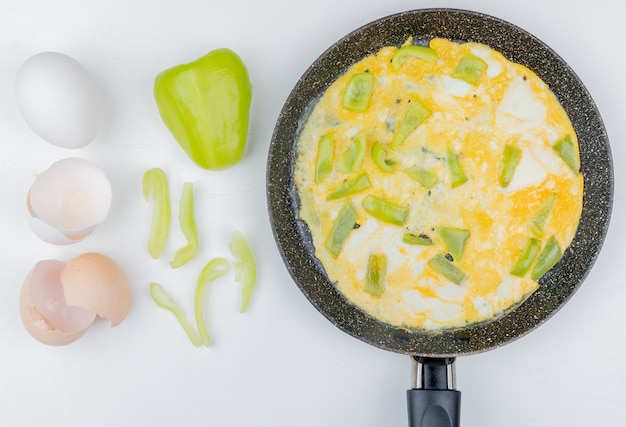Alright, let's talk omelets. You know, those fluffy, folded wonders that make you feel like a culinary wizard even when you've just chucked a few ingredients together. But honestly, there's more to it than meets the eye. Trust me, I've been there. There have been times I've ended up with a rubbery, overcooked mess, and let's not even mention the time I accidentally made a giant pancake instead of an omelet. But after years of trial and error, I've finally cracked the code. This guide is your key to omelet perfection, packed with tips, tricks, and recipes to take your breakfast game to the next level.
(Part 1) The Equipment: Your Omelet Arsenal

Let's face it, you can't whip up a perfect omelet with just any old pan. A good omelet pan is your secret weapon, your culinary sidekick. I've learned this the hard way. A decent non-stick pan with low sides is ideal, and here's why:
The Pan: Your Omelet's Canvas
- Non-Stick: No one wants to spend half the morning scraping their omelet off the pan. A good non-stick surface ensures a smooth, even cook, so your omelet slides right out, beautiful and intact.
- Low Sided: You need a pan with low sides so you can fold the omelet easily without it spilling everywhere. Plus, it helps the eggs cook evenly, ensuring a perfect golden brown color.
- Size: Choose a pan that's large enough to fit your desired omelet size, but not too big. You want the heat to be concentrated for a quick, even cook.
The Tools: Your Omelet Allies
You'll also need a few other tools to help you out:
- Spatula: A thin, flexible spatula is essential for flipping and folding. It should glide effortlessly under the omelet without tearing it, ensuring a smooth, clean fold.
- Whisk: A good whisk is key for whipping up those airy eggs. You want to create light, fluffy omelets, not dense, rubbery ones. Think of it as a mini-workout for your omelet, getting those air bubbles in.
- Bowl: A medium-sized bowl is ideal for whisking the eggs and adding any other ingredients. It should be big enough to allow for those vigorous whisking motions.
(Part 2) The Eggs: The Heart of the Matter

Eggs are the heart of any omelet, and the quality matters. I've found that fresh, cold eggs work best. Here's what I've learned over the years:
Egg Quality: Freshness is Key
You want to use eggs that are fresh and cold. They have a firmer consistency and hold their shape better while cooking, resulting in a fluffy omelet that doesn't fall apart. You're aiming for a beautiful, cohesive omelet, not a scattered mess.
egg size: Get Your Ratios Right
This really depends on your desired omelet size. If you're aiming for a small, solo omelet, one egg might be enough. But for a larger, shared omelet, you'll need more. Here's a general guide, but feel free to experiment:
| Omelet Size | Number of Eggs |
|---|---|
| Small (1 person) | 2 Eggs |
| Medium (2 people) | 3-4 Eggs |
| Large (3 people) | 4 Eggs |
The Temperature: Room Temperature is the Way to Go
Now, this is where it gets interesting. You want to bring your eggs to room temperature before you start whisking. I know, it might seem counterintuitive, but trust me. Room temperature eggs whip up better, creating a fluffier, airier omelet. Just leave them on the counter for 30 minutes or so before you start cooking. You'll be amazed at the difference it makes.
(Part 3) The Whisk: A Culinary Workout

Whisking is an art form, and it's all about getting the right texture.
Whisk with Purpose: Air It Out
You need to whisk those eggs vigorously. The goal is to incorporate air into the mixture. Don't be afraid to get a good workout in. Think of it as a mini arm session for your kitchen, getting those air bubbles in, creating that fluffy texture.
The Perfect Consistency: Not Too Stiff, Not Too Runny
You're aiming for a light, airy consistency. The mixture should have a frothy, almost bubbly appearance. It shouldn't be completely stiff, but it shouldn't be runny either. If you're not sure, just hold the whisk over the bowl. The mixture should slowly drip back in.
(Part 4) The Oil: Your Omelet's Lubricant
The key to a perfect omelet is even cooking, and oil is your friend in this journey, so let's discuss the dos and don'ts:
Oil Type: Butter, Olive Oil, or coconut oil?
Butter is the classic choice, but a good quality olive oil is also great. You want an oil that has a high smoke point, which means it can withstand high heat without burning. Coconut oil is a great alternative if you prefer a lighter flavour.
Oil Quantity: Less is More
Don't overdo it. Just a thin, even layer is enough to coat the pan. Too much oil will leave your omelet greasy and won't cook evenly. You want the omelet to cook quickly and evenly, not swimming in oil.
Oil Temperature: Hot but Not Smoking
The oil should be hot but not smoking. If the oil is too cold, the eggs will stick to the pan. If it's too hot, they'll burn. A good rule of thumb is to heat the oil until it shimmers slightly. This is your cue that it's ready for the eggs.
(Part 5) The Cook: The Art of the Flip
Now we get to the fun part - cooking the omelet. But don't get ahead of yourself, there's a method to the madness.
The Flip: Timing is Everything
You'll know it's time to flip when the bottom of the omelet is set and the top is still slightly runny. Use your spatula to carefully lift the edge of the omelet and gently fold it in half. If you're not confident, just slide the omelet onto a plate and fold it there, then slide it back into the pan to finish cooking. This gives you a little more control and less chance of a disastrous flip.
The Finish: Golden Brown Perfection
After flipping, cook for another minute or two until the top is set and the omelet has a golden brown color. There's nothing quite like that crispy golden edge. You're almost there, just a few more steps to go.
(Part 6) The Filling: Unleash Your Inner Chef
The fun part! This is your chance to unleash your creativity.
Classic Choices: The Tried and True
- Cheese: Cheddar, Gruyere, Swiss – you can't go wrong with classic cheese combinations. They add a creamy richness and melt beautifully into the omelet.
- Ham: Classic, salty, and always a crowd-pleaser. Ham adds a savory, salty depth to the omelet.
- Mushrooms: Sautéed mushrooms add a fantastic earthy flavour. They bring a wonderful texture and depth to the omelet.
- Onions: caramelized onions add a sweet and savory dimension. They add a touch of sweetness that contrasts beautifully with the savory eggs.
Get Creative: Think Outside the Box
But don't limit yourself. Try adding spinach, tomatoes, peppers, pesto, or even chorizo. The sky's the limit. Experiment with different flavour combinations, textures, and colours to create your own signature omelet.
Adding the Filling: Before or After?
You can add the filling to the omelet before or after folding. If you add it before, make sure it's cooked through. If you add it after, it will be a little less cooked, but it's a great way to add a bit of crunch. It all depends on your preference and the ingredients you're using.
(Part 7) The Finish Line: Seasoning and Garnish
Almost there! It's time to add the finishing touches.
Seasoning: Don't Forget the Salt and Pepper
Seasoning is crucial. A pinch of salt and pepper goes a long way. You can also add other herbs and spices to taste, like a sprinkle of paprika, chives, or parsley. Let your taste buds guide you.
Garnish: A Touch of Elegance
A little parsley or chives adds a touch of freshness and elegance. A sprinkle of grated cheese or a dollop of sour cream is a delicious finishing touch. You can even drizzle a little hot sauce or salsa for a bit of heat.
(Part 8) The Presentation: Making It Look as Good as It Tastes
Ok, it's not just about the taste, the presentation matters. You want your omelet to look as good as it tastes.
Plate It Up: Warm It Up
Slide the omelet onto a warm plate. This helps to keep it from sticking and maintains the warmth of the omelet.
Get Fancy: Add a Touch of Flair
You can garnish it with herbs, spices, or even a dollop of sour cream. For a more rustic look, fold the omelet in half and serve it on a piece of toasted bread. This gives it a more casual, homey feel.
(Part 9) The Recipes: Time to Get Cooking!
Ready to unleash your inner omelet chef? Here are a few of my favourite omelet recipes to get you started.
Classic Cheese Omelet: Simple, Yet Delicious
This is a simple, yet delicious classic. It's a great starting point for those new to making omelets.
- Ingredients: 2 large eggs, 1 tablespoon butter, 1/4 cup grated cheddar cheese, salt and pepper to taste.
- Instructions:
- Melt the butter in a non-stick omelet pan over medium heat.
- Whisk the eggs in a bowl with a pinch of salt and pepper.
- Pour the egg mixture into the hot pan and cook for about 1 minute, or until the bottom is set.
- Sprinkle the cheddar cheese over the top of the omelet.
- Fold the omelet in half using a spatula.
- Cook for another minute, or until the cheese is melted and the omelet is cooked through.
- Slide the omelet onto a plate and serve.
Mushroom and Spinach Omelet: Light and Healthy
A light and healthy option packed with flavor. This omelet is a great choice for a healthy, satisfying breakfast.
- Ingredients: 3 large eggs, 1 tablespoon olive oil, 1/2 cup sliced mushrooms, 1/4 cup chopped spinach, 1/4 cup grated Gruyere cheese, salt and pepper to taste.
- Instructions:
- Heat the olive oil in a non-stick omelet pan over medium heat.
- Add the mushrooms and cook for 3-4 minutes, or until softened.
- Add the spinach and cook for another minute, or until wilted.
- Whisk the eggs in a bowl with a pinch of salt and pepper.
- Pour the egg mixture into the hot pan and cook for about 1 minute, or until the bottom is set.
- Top with the mushroom and spinach mixture and sprinkle with the Gruyere cheese.
- Fold the omelet in half and cook for another minute, or until the cheese is melted and the omelet is cooked through.
- Slide the omelet onto a plate and serve.
Ham and Swiss Omelet: A Classic for a Reason
A classic for a reason. This omelet is a simple yet satisfying combination of flavours.
- Ingredients: 3 large eggs, 1 tablespoon butter, 1/4 cup chopped ham, 1/4 cup grated Swiss cheese, salt and pepper to taste.
- Instructions:
- Melt the butter in a non-stick omelet pan over medium heat.
- Whisk the eggs in a bowl with a pinch of salt and pepper.
- Pour the egg mixture into the hot pan and cook for about 1 minute, or until the bottom is set.
- Sprinkle the ham and Swiss cheese over the top of the omelet.
- Fold the omelet in half using a spatula.
- Cook for another minute, or until the cheese is melted and the omelet is cooked through.
- Slide the omelet onto a plate and serve.
(Part 10) FAQs: Your Omelet Questions Answered
Got questions? Don't worry, I've got you covered. Here are some common questions and answers to help you create your own omelet masterpiece.
What if my omelet is too thick?
If your omelet is too thick, it's likely you didn't whisk the eggs enough. Whisk them vigorously until they're light and airy. You want those air bubbles to create a fluffy texture, not a dense omelet.
What if my omelet is too thin?
If your omelet is too thin, it's likely you used too much oil. Just use a thin layer of oil to coat the pan. You want enough oil to prevent sticking but not so much that it makes the omelet greasy and prevents it from cooking evenly.
What if my omelet sticks to the pan?
If your omelet sticks to the pan, it's likely the pan wasn't hot enough or the eggs weren't cooked enough. Make sure the pan is hot before you add the eggs, and cook them until the bottom is set. You want the eggs to cook quickly and release easily from the pan.
What if my omelet burns?
If your omelet burns, it's likely the pan was too hot. Reduce the heat to medium and cook the omelet until the bottom is set. You want a gentle heat to cook the omelet evenly without burning it.
What if my omelet is too dry?
If your omelet is too dry, it's likely you overcooked it. Cook it for a shorter amount of time. You want the omelet to be cooked through but still slightly moist and tender.
Everyone is watching

How to Cook Frozen Lobster Tails Perfectly: A Step-by-Step Guide
RecipesLobster. Just the word conjures up images of lavish meals, special occasions, and a taste of luxury. But let's...

Pigs in a Blanket Cooking Time: How Long to Bake for Perfect Results
RecipesAh, pigs in a blanket. Just the name conjures up images of those delightful little parcels of crispy pastry en...

Pork Fillet Cooking Time: How Long to Cook It Perfectly
RecipesPork fillet, or tenderloin as it's sometimes called, is a real favourite in our house. It's so versatile, and...

The Ultimate Guide to Cooking Delicious Frankfurters
RecipesLet's face it, we all love a good frankfurter. It's a classic, simple, and always satisfying. But let's be rea...

Wolf Meat Recipes: A Guide to Cooking Wild Game
RecipesLet's be honest, you don't see wolf meat at your local butcher shop every day. It's a bit of a wild card, but ...
